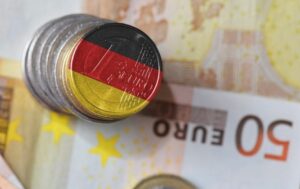
Consumer prices in Germany, harmonized with EU standards, rose by 11.6% in annual terms in October, according to preliminary data from the country’s Federal Statistical Office (Destatis).
Inflation accelerated from 10.9% in September and again renewed its historical maximum.
Analysts polled by Trading Economics expected inflation to remain at 10.9% on average.
Consumer price growth slowed to 1.1% month-on-month from 2.2% in September. Experts on average predicted an increase of 0.5%.
Inflation, calculated by German standards, in October accelerated to 10.4% in annual terms – the highest since December 1951, compared with 10% a month earlier. On a monthly basis, it slowed down to 0.9% from 1.9%.
Inflation in Germany is fueled by a weaker euro, an energy crisis and ongoing problems in supply chains.
Energy prices in the country rose by 43% in October, food prices rose by 20.3%, and the cost of services increased by 4%.
The final data on inflation in Germany for October will be published on November 11th.
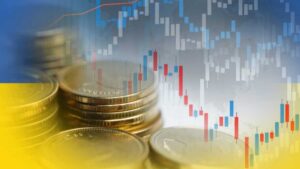
Ukrainian businesses in the third quarter worsened expectations of inflation over the next 12 months to 25.2% from 21.7% in the previous quarter and worsened expectations of hryvnia devaluation to 41.93 UAH/$1 from 36.06 UAH/$1.
According to the results of the regular quarterly survey of business expectations of enterprises in the country, released on the NBU website on Monday, the business expectations index (BIE) of enterprises rose to 79.5 percent from 72.6 percent in the previous quarter, indicating a softening of negative economic sentiment.
The central bank explained that the increase was due to improved estimates for all components of the index, most notably for total sales of own-produced goods.
It is noted that companies expect a slowdown of decline in production of goods and services in Ukraine in the next 12 months: the balance of responses is “minus” 37.9% in the third quarter compared to “minus” 48.7% in the second quarter of 2022.
The majority of companies (52.4%) expect their financial and economic situation to remain unchanged in the next 12 months, 31.3% expect it to deteriorate and 16.2% expect it to improve.
According to the report, 31.7% of respondents expect a reduction in sales volumes (compared to 43% in the second quarter), including in foreign markets, while 44.4% expect the volumes to remain unchanged.
According to the survey, 32.9% of enterprises intend to reduce the number of employees, 59.7% – leave the staff unchanged.
Reduced expectations of companies to increase salaries of workers in the next 12 months: 41.4% of respondents plan to increase wages, 50.8% – to keep at current levels, 7.9% – to reduce.
The percentage of companies that plan to attract foreign investment fell to 22.2% from 24.1%, according to the survey.
Loans in local currency are planned to attract 86.3% of companies, while in the previous quarter this proportion was 84.6%.
A total of 642 companies from 21 regions participated in the survey of business expectations, which was conducted between 1st and 31st of August 2022. Among those surveyed, 18.2% were companies in the processing industry, 21.2% in wholesale and retail trade, 14.6% in agriculture, 13.2% in transport and communications, 6.4% in mining, 5.1% in electricity and water supply, 3% in construction and 18.2% in other sectors.
The EDI is an aggregate indicator regarding the expected development of enterprises in the next 12 months. Calculated based on the results of surveys of enterprises as an arithmetic means of the balances of responses regarding the financial and economic situation of enterprises, total sales of own production, investment spending on construction works, investment spending on machinery, equipment and inventory, and the number of employees.
An index value of more than 100 indicates an advantage of positive economic sentiment in society, below 100 – negative economic sentiment.
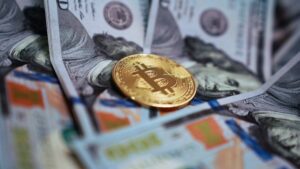
The rate of bitcoin fell by 4% during trading on Thursday after the publication of data on higher-than-expected inflation in the United States.
The price of bitcoin at 16:11 CST fell by 4.4% compared to the closing level of the previous trading and amounted to $18,312 thousand, which is the lowest level since June 18.
The rate of ether (Ether) fell by 6.6%, to $1.212 thousand.
Consumer prices (CPI index) in the US in September rose by 8.2% compared to the same month last year, showed data published on Thursday by the country’s Ministry of Labor. Thus, inflation slowed to a seven-month low from 8.3% in August, but was higher than the 8.1% expected by analysts polled by Bloomberg.
On a monthly basis, the CPI index increased by 0.4%, although analysts were expecting a rise of 0.2%.
Meanwhile, consumer price growth excluding the cost of food and energy (Core CPI) in September accelerated to 6.6% in annual terms from 6.3% in August.
“The whole world is looking at US inflation data to try and predict what the Fed is doing,” said Stefan Rast, founder of research firm Truflation.
Higher-than-expected inflation raises the possibility of another 75 basis point rate hike at the next Fed meeting on November 1-2.
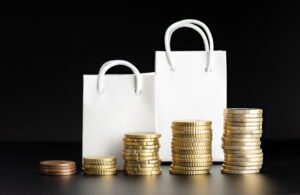
The National Bank of Ukraine (NBU) notes the presence of a number of factors on the market that contribute to the improvement of the price situation, and may reduce the inflation forecast for the current year, which was set at 31% in July, said Deputy Head of the NBU Serhiy Nikolaychuk.
Our last forecast for July (inflation) is about 30%, next year it will be about 20%. The risks are down: most likely, it will be revised (inflation forecast) a little lower, but not significantly,” he said at the Forbes conference “Without rose-colored glasses. Business and the state during the war” on Thursday.
Nikolaychuk explained that this was due, in particular, to the improvement in the situation with the supply of vegetables and fruits.
He added that fuel prices fell more than the National Bank expected, which is also related to logistics.
“The situation with the opening of ports also gives more reasons that there will be no large exchange rate fluctuations,” the deputy head of the National Bank said.
He also noted that in the July forecast, the National Bank included the introduction of an additional import duty and a higher excise tax on fuel, but these measures were not implemented, and this is also an additional deterrent effect on prices.
“Next year, the main disinflationary factor is the improvement in the ability of Ukrainian businesses to increase agricultural production, and logistics capabilities will improve,” Nikolaychuk said.
As reported, consumer price growth in Ukraine in August 2022 accelerated to 1.1% from 0.7% in July, and in annual terms, in August this year, inflation rose to 23.8% from 22.2% in July and 21.5% in June.
As reported, in 2021 inflation in Ukraine rose to 10% from 5% in 2020 and 4.1% in 2019, while core inflation rose to 7.9% against 4.5% a year earlier.
The NBU predicted an acceleration of inflation this year to 31%, including up to 25.6% in the third quarter.

Consumer prices (HICP index) in the euro area in September increased by 10% in annual terms, according to preliminary data from the Statistical Office of the European Union.
Thus, inflation accelerated compared to 9.1% in August and updated the maximum since the beginning of the calculations.
Analysts polled by Trading Economics had expected a less significant increase of 9.7%.
The current inflation rate is five times the European Central Bank’s (ECB’s) target of 2%.
Consumer prices excluding food and energy increased by 4.8% in annual terms in September compared to 4.3% in the previous month.
The cost of energy resources soared by 40.8% (in August – by 38.6%). Food, alcohol and tobacco rose in price by 11.8% (by 10.6%), industrial goods – by 5.6% (by 5.1%), services – by 4.3% (by 3.8%) .
Consumer prices excluding food and energy (CPI Core index) this month increased by 4.8% in annual terms against 4.3% in August.
The growth of consumer prices in the euro area in September amounted to 1.2% compared to the previous month. In August, this figure increased by 0.6%.
The lowest inflation was recorded in France (6.2% in annual terms), Malta (7.3%), Finland (8.4%) and Ireland (8.6%). The most significant rise in prices occurred in Estonia (24.2%), Latvia (22.4%) and Lithuania (22.5%).
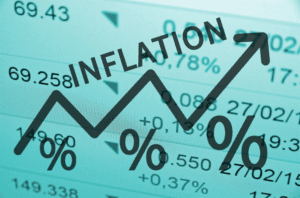
The growth of consumer prices in Ukraine in July 2022 due to seasonal factors slowed down to 0.7% from 3.1% in June and 2.7% in May, returning to the level of the end of last year, the State Statistics Service reported (Gosstat) on Wednesday.
In July last year, inflation was 0.1%, so in annual terms, in July this year, it rose to 22.2% from 21.5% in June and 18% in May.
Core inflation over the past month also fell to 1.2% from 1.6% in June and 1.4% in May. However, taking into account the core deflation of 0.1% in July 2021 in annual terms, it increased to 16.7% from 14.9% in June and 13.7% in May.
Since the beginning of this year, for the first seven months, inflation in Ukraine amounted to 18.2%, and the base – 12.7%, said the State Statistics Service.
In the consumer market in July, prices for food and non-alcoholic beverages rose by 0.8%. Most of all (by 8.7%) the price of eggs rose. Prices for processed cereals, rice, pork, lard, fish and fish products, non-alcoholic drinks, bread and butter increased by 5.1-1.1%. At the same time, prices for fruits, beef and vegetables fell by 5.4–1.9%.
Prices for alcoholic beverages and tobacco products increased by 1.3%, incl. for tobacco products – by 1.8%, alcoholic beverages – by 0.8%.
Clothing and footwear fell in price by 3.5%, including footwear – by 3.8%, clothing – by 3.2%.
Transportation prices decreased by 0.3% mainly due to cheaper fuel and lubricating oils by 4.4%. At the same time, the cost of travel in road passenger transport increased by 2.9%.
In the field of communications, prices increased by 2.1%, which is associated with an increase in the cost of mobile communications by 4.1% and postal services by 2.6%.
As reported, in 2021 inflation in Ukraine rose to 10% from 5% in 2020 and 4.1% in 2019, while core inflation rose to 7.9% against 4.5% a year earlier.
The NBU predicts that inflation will accelerate to 31% this year, including up to 25.6% in the third quarter.